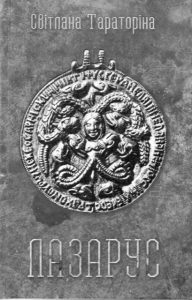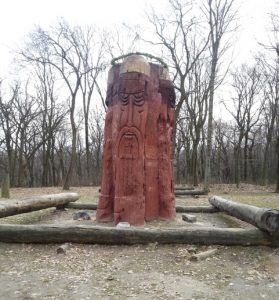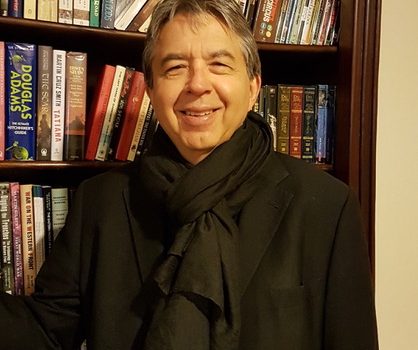Michael Burianyk Guest Post–“Ukrainian Gods: Slavic Myths and Legends for Fantasy Writers”
My gratitude and appreciation to Natalia Burianyk, Anastasia Rohoza, Natalie Kononenko, Christine Worobec, Rachel Cordasco and Svitlana Taratorina for their input and support. All misunderstandings and misinterpretations are mine.
In American Gods, Neil Gaiman has Mr. Wednesday say of Czernobog and his family, “They’re not Rom. They’re Russian. Slavs. I believe.” Why would they be confused with the very un-Slavic Rom (“gypsies”)? Why is Czernobog, more often associated with Western Slavs, identified as Russian? Why does Wednesday, who seems to be very familiar with the American Gods, only “believe” and not know? It may well be simply a commentary of how uncomfortable Westerners are with Slavic cultures and, at that, only recognize the Russian element. There is also an ongoing contemporary criticism of Eurocentric bias in English-language fantasy. While vitally important and germane, it ignores the point that there is an almost invisible Eastern European and Slavic presence in western fantasy. This “Other Europe” is very much terra incognita, no less than Africa, the Middle East or Asia.
Russia is not the only, or even earliest, source of Slavic myths and legends. Much of the confusion lies in the use of the word “Russia”. The first Eastern Slavic state, founded in the 8th-9th century AD, was known as Rus’ or Kyivan Rus’, after its centre of Kyiv. It was a loose collective of several culturally related principalities. The Grand Dukes of Muscovy appropriated “Rus’” as “Rossiya” in the 15th century as they annexed neighboring polities. This was rendered into English as “Russia”. Even in the late 19th and early 20th centuries, Ukrainians were known as “Ruthenians”, a Latinization of “Rus’ian”. The Lemko people of Trans-Carpathia—isolated geographically and temporally from Russia— still call themselves and their language “Ruskiy”. Belarus and Belarusian harken back to pre-Muscovite times. It is clear that “Russia” is very often an imperial and political label rather than an ethnic or cultural one.
There are a few examples of Slavic mythology in English language Fantasy—C. J. Cherryh’s Rusalka novels, Katherine Arden’s Winternight Trilogy, and Catherynne Valente’s Deathless come to mind. These, however, are problematic in the fact that they portray their Slavic background through a generic “Russian” window. The nuances, distinctions and richness of the varied Slavic cultures are lost.

This article is an appeal for the inclusion of Slavic mythology in English language fantasy. To that end it is an introduction to Ukrainian myth and legend—to Ukrainian Gods if you will. Ukrainian culture and mythology are an important part of the diverse Slavic cultures as well as an essential complement and foil to the distorting influence of Russia.
Original sources on East Slavic gods and associated beliefs are scarce, contradictory and not always reliable. The first chronicles weren’t written until Christian times, with Christian prejudices, around the turn of the first millennium, and the authenticity of some is still argued over. However, there is a consensus on which gods existed in the minds and souls of the early Slavs, who worshipped gods of sky, sun and fire, such as Svarog, Dazhbog and Svarovich. In the 10th century, Prince Volodymyr of Kyiv, years before accepting Christianity, made an effort to put some order into the older pagan beliefs. The Slavic gods were worshipped without temples and often without physical representation. In a possible attempt to conform to more sophisticated religions Volodymyr ordered six idols to be erected on one of Kyiv’s many hills. Of these, Perun, Dazhbog and Strybog are thought to be originally Slavic, while Khors and Simargl are considered sops to the minor Persian elements of the Kyivan realm. Dazhbog was a son of Svarog, perhaps a Slavic Vulcan. Strybog seems to have been a god of the winds. Khors was another sun god, and Simargl was a winged dog involved in agriculture. The sixth, Mokosh, the only goddess, could be from the Finno-Ugric component of the Rus’ian alliance and may have been associated with the nebulous “moist mother earth” (mokra is a Ukrainian word for “wet”).
The two most important gods of Kyiv were Perun and Veles. The participants of Rus’ trading and raiding expeditions swore their oaths to one or the other. Perun, silver headed and golden mustached, to whom oxen were sacrificed and for whom oaks were sacred, took pride of place. He was particularly worshipped by warriors. He wielded a stone hammer and created thunder, lightning and rain. His thunderbolts—Perun’s arrows—were often found on the ground as petrified lightning. Veles was missing from Volodymyr’s hill but had his idol venerated in Kyiv’s merchant quarter. He was the god of cattle and, by extension, of riches, wealth and prosperity. He had possible connections to the dead. There are some who believe that Perun and Veles were in opposition to each other, but this is disputed by certain academics.
Several years after the idols were installed, Volodymyr accepted Byzantine Christianity for Rus’. He had Perun’s statue torn down, beaten with sticks, dragged behind a horse and thrown into the Dnipro River. The bank on which it eventually washed up on, beyond the rapids of the river, was called “Perun’s Shore”. Veles suffered a similar fate; his stone idol was thrown into the river near where it had been worshipped in Kyiv’s Podil district. Resistance to the new religion, particularly amongst the commoners, created a “dual faith” (more academically, a “vernacular religion”). This was called “Perun’s Revenge”, where the god took over the identity of the Judeo-Christian Prophet Elijah, while his colleague Veles appropriated the identity of St. Vlasii.The new hybrid religion, a heady brew of pagan nature worship and Christian myth and imagery, was taken to extremes in the Slavic East as compared to other areas of Europe.
The holidays of Malanka (New Year and Christmas season) and Paska (Easter) unapologetically kept their pagan origins. The summer solstice festival of Ivan Kupalo took only its name (John the Baptist) from Christianity and kept its prehistoric features of bonfires, revelling, fortune-telling and courtship. Ukrainian peasants lived very close to and very much in awe of nature. Everything that surrounded them—rivers, forests, the fields—was suffused with some sort of spirit, good, evil or indifferent. The dual faith not only allowed this persistence of ancient celebrations but guaranteed that a rich and bewildering underworld of demons and otherworldly beliefs would live on until even modern times.

Ukrainian mythology abounds in several related spirits who were revenants of stillborn and unbaptized girls and those who’d suffered untimely deaths from drowning, suicide and other tragedies. The Rusalka, the water nymph, is perhaps the most well-known. Unlike human girls and women who covered their braids, the Rusalka had long, flowing unbound hair, hiding her naked beauty. She was a denizen of rivers, lakes and wells. The waves on the water are her dances and the susurrus of running water her song. Her music captivated young bachelors who, if unwittingly charmed, could be tickled to death. The Mavka (also Naivka) is a forest nymph. Like the Rusalka, she took the form of a loose-haired beauty, often naked or dressed in a thin shift. If a Mavka were naked and her back was turned to you, you might see a gaping hole revealing her hollowness. She did not always have malicious intent, sometimes helping cowherders take care of cattle in the mountain valleys. However, she too could sometimes be guilty of tickling her human lovers to death. The Polianytsia (field nymph) was another dead girl, dressed in green and associated with pride, freedom and independence. The Povitrulia (wind nymph) was fond of shepherds and would protect their flocks if she wasn’t denied her amorous needs.
In contrast, male spirits were generally more malevolent. The Poliovyk (field demon) inhabited fields and meadows and was deemed to have been sired by the Christian devil or one of the older and darker pagan gods. The Lisovyk (forest demon) was an old hairy man whom you might be unfortunate to meet after getting lost in the woods, and the closely related Blud might have been the demon who lured you there in the first place. The Vodianyk was another bearded old man with a tail whose thrashing could cause flooding, a truly malevolent water demon. His marsh dwelling relation, the Bolotianyk, was fat, eyeless, and frog-like. He didn’t move much, sitting at the bottom of the swamp, mimicking pipe music and other sounds that lured the unsuspecting into the mud.
The domestic lives of Ukrainians were influenced by other spirits. The Perelesnyk was an incubus, who could enter a woman’s home through her chimney or window and, by assuming the appearance of a dead husband or lover, seduce her. The Mara was a female demon who caused anguish through strife, gossip and sickness, perhaps personifying the stresses of village life. The Domovyk (house spirit), sometimes called Khovanets (“the hidden one”), took many shapes, such as a mouse or a little old man, hiding in the shadows behind the oven. Generally, he kept the home cozy, helping with the housework. Unlike the Russian Domovoy, the Ukrainian Domovyk was not thought to have his origin as an ancestral spirit. It was only under the influence of Christianity, and even then not until the 19th century, that any malevolence was attributed to him. Other devils, demons and unclean spirits—chorts and didkos—existed and were only well distinguished by their general malice. They were thought to be created by either Lucifer or some vile pagan predecessor. As far as the devil, Ukrainian folklore often portrayed him as a comic figure, easily outwitted by a clever peasant.
The werewolf and vampire were known in Ukraine as Vovkulaka and Upyr. Herodotus wrote about an ancient Slavic tribe residing in what is now Ukraine who could transform themselves into wolves. There is a published account of a woman’s body found within the foundations of an old building on one of Kyiv’s ancient hills. She was non-canonically buried with her head to the north with her torso pierced with an iron spike, bent so as not to allow for an easy escape. In another report, a skeleton was found elsewhere in Kyiv with an iron nail through it. It is worth noting that some academics contend that the modern, western Vampire mythos was originally a product of Slavic culture.
Ukrainian magical practice, witchcraft and sorcery, goes back to the ancient volkhvs—shamanistic pagan sorcerers and sorceresses. It wasn’t until the early 18th century that distinctions between good and evil magic appeared. Even so, boundaries between malevolent sorcery and magical healing tended to remain indistinct. Much malign witchcraft consisted of “spoiling”—common, daily misfortunes caused by an evil practitioner. A victim of spoiling or the evil eye could turn to a healer for relief. Such practices are still current in rural Ukraine and are well documented in academic papers and documentaries.
Witches (Vid’mas) and sorceresses were more prominent than their male counterparts—sorcerers and warlocks (Chakhluns). Ukrainian witches, who held their ribald sabbaths on Kyiv’s Bald Mountain, were often considered to be beautiful young widows, as opposed to old Russian hags like Baba Yaga. A born witch was the seventh daughter of seven daughters, or a girl born with a tiny tail. Such witches were usually healers and only caused harm inadvertently. Other witches acquired their powers by dealing with so-called unclean forces, the Christian devil being only one of them. Generally, however, witches were not Satanists. Much of the practice of witchcraft wasn’t viewed as either demonological or satanic. Most witches attended church and accepted the sacraments. Witchcraft and sorcery in Ukraine were not considered the blasphemous crime they were in the Catholic and Protestant world. If malign, magical practice was considered a criminal act but wasn’t punished as severely. Though burning at the stake wasn’t unknown, most punishments consisted of fines or church penance. Some evidence shows that the upper classes were more likely to think of witchcraft as synonymous with Satan, while peasants, closer to ancient pagan beliefs, considered the practices to be a normal part of their lives.
Ukrainian mythology is complemented by the rich tradition of heroic stories and legends. Bylynas, epic songs from the 11th and 12th century, recount the fantastic adventures of legendary bogatyrs of the Kyivan court of Prince Volodymyr, Volodymyr the Red Sun. These epics feature knights and heroes, such as Ilya Muromets (whose relics are supposedly preserved in Kyiv’s Monastery of the Caves), Dobrynya Nikitich and Alyosha Popovych. The Kozaks (Cossacks), warriors and frontiersmen of the Black Sea steppes of the 16th-18th centuries, are prominent in Ukrainian culture. They parallel the gunslingers of the American west and Japanese Ronin Samurai. Their stories are told in dumas (epic songs) performed by kobzars—blind itinerant minstrels. Some tales include Kozak warlock-shapeshifters called Kharakternyks.
In conclusion, though we can accept the desire for authenticity, we have to recognize that all myths and legends are contradictory, and any particular story doesn’t necessarily belong exclusively to any particular group. Tales change with time and with the teller and straddle both linguistic and geographic borders. In the end, gods, demons and even heroes are all made-up. What stories we tell and how we tell them are just fuel for making up more. However, there is no doubt that the forgotten parts of Slavic Europe, like Ukraine, are a rich source of ancient, lush and complex fantastic lore that cannot be ignored.

Michael Burianyk, in an alternate universe, is a geophysicist and the author of Understanding Signals, published by the Society of Exploration Geophysicists. In this world however, he is a passionate devotee of fantasy and science fiction and has an interest in history, myth, language and storytelling. He is the author of “SF in Ukraine” in the January 2018 issue of Locus. He is a Canadian living on the French Cote d’Azur and not missing the snow one little bit.






What a great article! I’m a non-fiction writer writing about ukrainian spiritual practices and I loved this article. Thank you so much for sharing.
I grew up in Ukraine, I loved Gogol’s books and I was interested to learn about these folk legends. The author of this article is a creative person and therefore loves a lot. My profession is geophysics. I met Michael Burianyk when I was setting up an international geophysical student section in Kyiv. Recently, Mikhail surprises with his writing talent. He has already published his second monograph on seismic exploration. And now I have studied and interestingly described the Slavic pagan gods and spirits. Thanks for the informative article and the joy of meeting you!